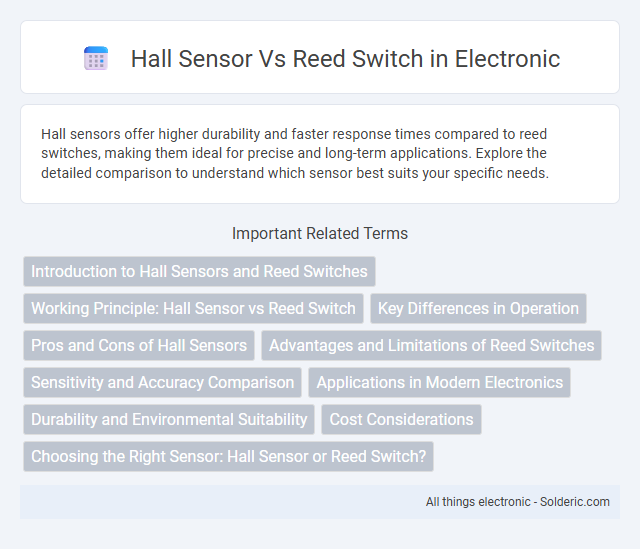Hall sensors offer higher durability and faster response times compared to reed switches, making them ideal for precise and long-term applications. Explore the detailed comparison to understand which sensor best suits your specific needs.
Comparison Table
| Feature | Hall Sensor | Reed Switch |
|---|---|---|
| Operating Principle | Detects magnetic field via Hall effect | Mechanical contacts actuated by magnetic field |
| Response Time | Fast, in microseconds | Slower, mechanical delay |
| Durability | High, solid-state, no moving parts | Lower, mechanical wear and tear |
| Sensitivity | Highly sensitive and precise | Less sensitive, requires stronger magnet |
| Power Consumption | Requires continuous power | No power needed for detection |
| Output Type | Analog or digital output | Mechanical open/close switch |
| Environmental Robustness | Resistant to shock and vibration | Susceptible to mechanical damage |
| Typical Applications | Speed sensors, proximity detection, current sensing | Security systems, door sensors, simple position detection |
Introduction to Hall Sensors and Reed Switches
Hall sensors detect magnetic fields through the Hall effect, offering precise, contactless measurement and long-lasting durability in various applications such as speed detection and proximity sensing. Reed switches consist of two ferrous contacts sealed within a glass tube that close or open when exposed to a magnetic field, providing a simple and cost-effective solution for on/off switching. Your choice between these technologies depends on factors like response time, reliability, and environmental conditions.
Working Principle: Hall Sensor vs Reed Switch
A Hall sensor operates based on the Hall effect, generating a voltage output proportional to the magnetic field when a conductor carrying current is exposed to a magnetic field. In contrast, a reed switch consists of two ferromagnetic reeds sealed in a glass capsule that physically close or open the circuit when exposed to a magnetic field. The Hall sensor provides a solid-state, contactless method with analog or digital output, whereas the reed switch relies on mechanical movement for switching.
Key Differences in Operation
Hall sensors utilize the Hall effect to detect changes in a magnetic field, producing a voltage proportional to the magnetic flux density. Reed switches operate by physically closing or opening electrical contacts in response to a magnetic field, providing a binary on/off signal. Unlike reed switches, Hall sensors offer non-contact, solid-state operation with higher durability and faster response times.
Pros and Cons of Hall Sensors
Hall sensors offer high durability and long lifespan due to their solid-state design, making them resistant to mechanical wear and environmental factors. They provide precise, contactless magnetic field detection and fast response times, suitable for applications requiring reliability and accuracy. However, Hall sensors can be more expensive and sensitive to electromagnetic interference compared to reed switches, which may influence your choice depending on the application's complexity and budget.
Advantages and Limitations of Reed Switches
Reed switches offer advantages such as low power consumption, high reliability in low current applications, and simple design suitable for detecting magnetic fields without external power. Limitations include mechanical wear due to moving contacts, limited switching speed, sensitivity to vibration or shock, and reduced lifespan compared to solid-state sensors like Hall sensors. Your choice depends on application requirements, where durability and fast response may favor Hall sensors over reed switches.
Sensitivity and Accuracy Comparison
Hall sensors offer higher sensitivity and greater accuracy compared to reed switches, detecting minute changes in magnetic fields with precise output signals. Reed switches, relying on mechanical contacts, exhibit lower sensitivity and are prone to contact bounce, resulting in less consistent measurements. This makes Hall sensors ideal for applications requiring fine magnetic detection and dependable performance.
Applications in Modern Electronics
Hall sensors and reed switches serve critical roles in modern electronics with distinct application domains shaped by their operating principles. Hall sensors are widely utilized in automotive systems for position sensing, speed detection, and current sensing due to their robustness, rapid response, and contactless operation. Reed switches remain favored in security systems, proximity detection, and simple switching tasks, valued for their low cost, ease of integration, and ability to function in low-power environments.
Durability and Environmental Suitability
Hall sensors offer superior durability compared to reed switches, as they contain no moving parts and are less prone to mechanical wear and failure. Their solid-state design enables Hall sensors to perform reliably in harsh environments, including extreme temperatures and exposure to dust, moisture, and vibration. Reed switches, while cost-effective, are vulnerable to mechanical fatigue and corrosion, limiting their suitability for long-term or demanding environmental applications.
Cost Considerations
Hall sensors generally have a higher upfront cost compared to reed switches due to their semiconductor components and more complex design. Reed switches are cost-effective for simple on/off applications, making them ideal for budget-sensitive projects. Your choice should balance cost with performance requirements, as hall sensors offer longer lifespan and better durability, potentially reducing total cost of ownership.
Choosing the Right Sensor: Hall Sensor or Reed Switch?
Choosing between a Hall sensor and a reed switch depends on your application's requirements for durability, sensitivity, and response time. Hall sensors offer solid-state reliability, faster response, and better suitability for high-speed or continuous monitoring, while reed switches provide cost-effective, simple operation with physical contact, ideal for low-frequency or intermittent detection. Evaluating your environment, power constraints, and expected sensor lifespan will help you select the best option for your system's performance and maintenance needs.
Hall Sensor vs Reed Switch Infographic

 solderic.com
solderic.com